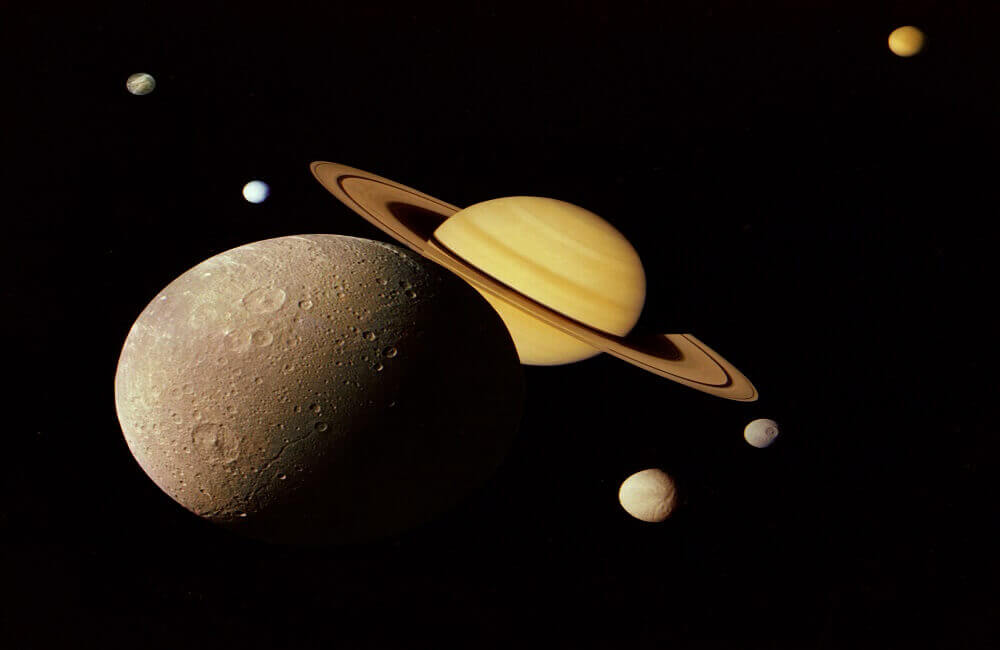
We often see science fiction shows featuring life on distant planets with multiple moons and suns. We see multiple silhouettes visible in the sky when a person looks up, be it Tatooine or Titan. This makes us want to have more than one of each to look at when we turn our heads upwards. Earth has only one moon, but other planets in our very own solar system are known to have several moons. Yes, even other planets have moons too. But our moon is uncommon because of its unusually large size. So, have you ever wondered which planet has the most moons in our Solar System? Have you wondered which planet would make the life shown in sci-fi movies possible? Which planet’s sky would be full of large pretty celestial bodies when we look upwards from the surface? We’ll answer all this and more in this article. So stay tuned!
What Is A Moon?
Have you ever wondered what exactly is the moon, the jewel that adorns the night sky of the earth? Essentially, a moon is a celestial body or a natural satellite that orbits around a planet, i.e. it is for a planet what a planet is to a star sustaining a Solar System. The earth’s moon, visible in the night sky is the most common example of a natural satellite that can be understood even by a layman. However, there are countless moons to the countless planets in the Universe. A moon affects its planet’s atmosphere. As on earth, the moon’s gravitational pull affects tides in the ocean and seas all over the globe. Similarly, moons of other planets have some effects or the other. Going by that theory, when the planet has more than one moon, the effects would be just that much more.
Which Planet Has The Most Moons?
Having only one moon revolving around it, the earth is certainly not a runner in the race for the planet with most moons. Until very recently, Jupiter was the planet with the most moons at 79, but a recent discovery revealed that it is, in fact, the beloved ringed planet, Saturn that has the most moons. Saturn has 82 moons orbiting around it, of which 20 were very recently discovered on 7th October 2019 using the telescope placed in Hawaii. The smallest moon discovered was as small as 5km in diameter. It is further speculated that there still might be numerous smaller undiscovered moons orbiting Saturn, that need yet more powerful telescopes to be seen from earth.
Why Do Planets Have Moons?
It is quite essential to know how moons are formed when answering which planet has the most moons. And how do they come to be in a particular planet’s orbit? Moons are formed during the formation of a planet, mostly by the debris that is left behind in the orbit after the formation, held together by the planet’s core’s gravitational pull. Also, this may sometimes constitute a mass of gases and clouds as is the case with many of Saturn’s and Jupiter’s moons. During a planet’s lifetime, it comes across several asteroid collisions. Sometimes, an asteroid gets pulled into the orbit and forms another moon of the planet instead of hitting it. The asteroid passes by the gravitational pull and gets sucked into the orbit rather than following its due course. This is the reason that Jupiter and Saturn have numerous moons and might account for why Saturn is the planet that has the most moons.
The Various Moons Of Saturn
It has now been established that Saturn has the most moons among the planets of our Solar System. Of Saturn’s 82 moons, only 53 moons have been named, the other 29 have yet to be named. Some of the most famous moons of Saturn are Titan, Enceladus, Iapetus, Methone, and many more. The moons of Saturn are very different from one another, in size, composition, and other properties. Titan is famous among comic lovers as the home of Thanos, but in the real world, there is not yet any proof of life on Titan. Titan, the largest moon of Saturn, is bigger than the planet Mercury. Titan has fascinated scientists since its discovery due to its earth-like liquid cycles. Recently NASA has even sent probes to Titan to help study it further, to see if life might be possible on its surface. Apart from this, the moon Enceladus has eluded scientists with its spewing jets of icy ocean water, which leads them to believe it might have a good chance of sustaining life.
The newer moons of Saturn are much smaller in size compared to the moons that were discovered much earlier. Their size is one of the main reasons that it took so much time to discover them in the first place. It is still being confirmed whether all these newly discovered bodies are in fact moons or could just be debris or asteroids that are just passing by the ringed gas giant.
What The Future Might Hold?
Just imagine being on the surface of Saturn and looking up at the sky. You will be able to see 82 moons up there. It would be 82 times more pleasant to stargaze at nights if life were possible on Saturn and we could witness this magnificent sky with our own eyes. Who knows whether it will be possible for the next 50 years or even a century? But once humans figure out how to traverse space, these sights will be common but nonetheless spectacular. Saturn, the planet that has most moons, surrounded by its magnificent rings and 82 moons, might be a favorite tourist destination once space tourism is possible for humans.
You May Also Like:
- Which Planet Rotates Clockwise?
- Which Planet Has The Most Volcanoes?
- Which Planet Is Closest To Earth?
